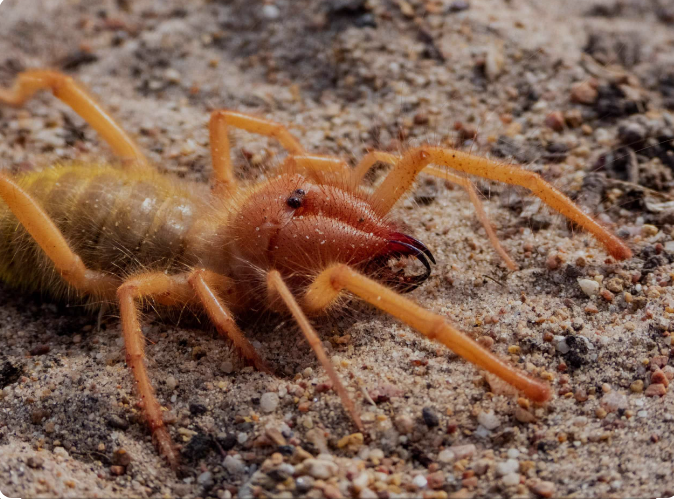Unveiling the Mysteries of the Camel Spider: Nature, Habitat, and Impact on Humans and Pets in the US

spiders in australia
Camel spiders, the arachnids that have been the source of numerous myths and misconceptions, inhabit various regions across the world, including certain parts of the US. Understanding these fascinating creatures is crucial to dispel the fears associated with them and to appreciate the role they play in the ecosystem.
Also Read:- Understanding aardwolf: Unraveling the Mysteries of this Unique Species and its Comparison with Hyenas
What is a Camel Spider?
Camel spiders, also known as wind scorpions or sun spiders, belong to the order Solifugae. Despite their name, they are neither true spiders nor scorpions. They are characterized by their large chelicerae (jaws) and are predominantly found in desert regions. With approximately 1000 described species, these arachnids have an array of features that can either enthrall or horrify, depending on one’s perspective.
Habitat: Where do Camel Spiders Live in the US?
Camel spiders predominantly inhabit arid and semi-arid regions. In the United States, they are mostly found in the southwestern states like Arizona, California, and New Mexico. These areas provide the ideal conditions—warm and dry—for camel spiders to thrive. They are adept at burrowing and usually seek shelter in the shadows during the day to escape the scorching sun and become active at night when the temperatures are more bearable.
The Bite: How Bad Does a Camel Spider Bite Hurt?
A widespread concern about camel spiders is their bite. While their jaw structure may look intimidating, camel spiders are not venomous, and their bite, although painful, is not lethal to humans. The pain associated with a camel spider bite is usually due to their powerful jaws, which can break the skin and cause mechanical damage. Immediate medical attention is recommended to prevent secondary bacterial infections from a camel spider bite, especially in the rare cases where an individual may be allergic to their saliva.
Harmlessness: Are Camel Spiders Harmless?
The majority of camel spiders are relatively harmless to humans and pets. They are not aggressive and usually try to flee from human interaction. Most stories about their aggressiveness are largely exaggerated. They do not possess venom glands, and hence, their bite is not poisonous. However, their jaw strength can make a bite painful. They primarily feed on termites, insects, and other small animals, contributing to pest control in their native habitats.
Impact on Pets: Can a Camel Spider Hurt a Cat?
Pets, particularly cats, may encounter camel spiders in regions where they are prevalent. While a camel spider can inflict a painful bite, it is unlikely to cause severe harm to cats or other pets. However, caution is advised, and it is best to monitor interactions between pets and camel spiders to avoid any potential harm, especially considering the risk of secondary infections in bite wounds.
Dispelling the Myths
Many myths surround camel spiders due to their ominous appearance and swift movements. Stories from soldiers stationed in the Middle East during the Iraq war contributed to the fearful reputation of camel spiders, with claims of them devouring camel stomachs and running at speeds matching a human. However, these stories are largely unfounded. Camel spiders can run swiftly but not at human speed, and they do not have a diet consisting of large mammals.
Eco-Biological Importance
Camel spiders play a significant role in the ecological balance of arid regions. By preying on various insects and other small creatures, they contribute to controlling the population of potential pest species. Their presence is indicative of the overall health of the ecosystem, reflecting the diversity and abundance of life in seemingly inhospitable environments.
Human Interaction and Safety
While encounters with camel spiders can be daunting due to their unusual appearance, it is important to remember that they are generally not a threat to humans. Maintaining a safe distance and avoiding provocation can prevent any undesired confrontations. In areas where camel spiders are prevalent, ensuring that homes are properly sealed can reduce the likelihood of them entering living spaces.
Conservation Status
Camel spiders, like many other arachnids, face threats from habitat destruction, climate change, and human encroachment. Protecting their habitats and understanding their ecological importance is vital for their conservation. Increased awareness and education about camel spiders can help in mitigating unwarranted fears and promote coexistence with these unique creatures.
Conclusion
Camel spiders are intriguing arachnids with distinct features and behaviors, predominantly found in the arid regions of the southwestern United States. They are generally harmless to humans and pets but can inflict painful bites due to their strong jaws. Despite the myths and fears surrounding them, camel spiders play an essential role in maintaining ecological balance in their native habitats. Awareness, understanding, and respect for these creatures are pivotal for harmonious coexistence and conservation in the ever-changing environment.
Summary:
Camel spiders, unique arachnids found in the southwestern US, are subjects of numerous myths. While they can inflict painful bites with their strong jaws, they are generally harmless and not venomous. The ecological role they play in controlling pest populations in arid regions is crucial, and understanding their nature and habitat is vital to dispelling fears and promoting conservation efforts.
FAQS
- What is a Camel Spider?
- A camel spider is a type of arachnid, belonging to the order Solifugae, commonly found in arid regions, and is neither a true spider nor a scorpion.
- Where do Camel Spiders Live in the US?
- Camel spiders are predominantly found in the southwestern states of the US, such as Arizona, California, and New Mexico.
- How Bad Does a Camel Spider Bite Hurt?
- A camel spider bite can be painful due to their powerful jaws but is not venomous or lethal to humans.
- Are Camel Spiders Harmless?
- Generally, camel spiders are harmless as they are not venomous and tend to avoid human interaction, but their bites can cause discomfort.
- Can a Camel Spider Hurt a Cat?
- While a camel spider can inflict a painful bite, it is typically not severe for cats or other pets, but monitoring interactions is advised to avoid potential harm.
- Do Camel Spiders Have Venom?
- No, camel spiders do not possess venom glands and their bites are not poisonous








